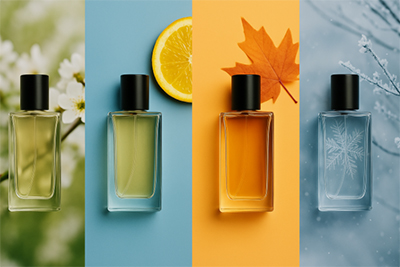|
||||||||||||
Seasonal Scent Wardrobes: How To Choose Fragrance By Weather And Mood |
||||||||||||
|
Most people change their clothing with the seasons without thinking twice. Lighter fabrics in summer, layers in winter, a touch of warmth in autumn. But when it comes to fragrance, many stick to the same bottle year-round. That approach may overlook one of scent’s greatest qualities—its ability to reflect and enhance your state of mind, your energy, and the season you’re living in. Just like music or color, scent interacts with its surroundings. A warm, spicy perfume might feel comforting in the cold but overwhelming in July. A crisp citrus note might smell clean and fresh in summer but get lost in a snowstorm of winter layers. Building a seasonal scent wardrobe is less about collecting dozens of bottles and more about aligning fragrance with mood, temperature, and occasion. One approach that’s gaining popularity is the mixology perfume concept—where individuals blend or layer fragrances to suit their environment or emotional state. This modern take on personalization allows a single bottle to be worn differently across seasons. How weather changes fragrance behaviorTemperature plays a critical role in how perfume develops on your skin. In hot climates or warm months, skin tends to be oilier and warmer, which causes scent molecules to evaporate more quickly. This amplifies top notes like lemon, bergamot, and neroli, but it can also make heavy ingredients feel overpowering. In contrast, cooler weather slows the evaporation process. That allows deeper base notes—woods, resins, leathers—to shine for longer, giving you a more grounded and lasting impression. Humidity, wind, and even your own hydration levels can impact how a fragrance behaves. That’s why one bottle can feel bright and energetic in spring and slightly dull by winter. Spring: rebirth in scent formSpring scents are often built around green, floral, and citrus accords. Think of blooming gardens, fresh herbs, and morning dew. Notes like hyacinth, violet leaf, pear blossom, and petitgrain work well for this season. These scents tend to match the upward mood of spring—hopeful, fresh, full of motion. They’re ideal for daytime wear, for walks in light jackets and open windows. If you’re experimenting with mixology-style layering, a soft floral base with a touch of green tea or ginger on top can create a balanced and uplifting profile. Summer: keep it light, let it breatheHot weather demands restraint. Fragrances that are too sweet, spicy, or heavy can become cloying when amplified by heat. Instead, reach for aquatic, citrus, or herbal scents—grapefruit, mint, fig, sea salt, or white florals like jasmine and neroli. These types of fragrances often come in eau de toilette or body spray formulations, making them easier to reapply throughout the day without overwhelming the senses. They're also excellent candidates for layering with body mists or scented lotions for a softer impact. Autumn: warmth without weightAs the air gets cooler and the leaves turn, scent preferences shift toward slightly richer profiles. This is the time for fig, plum, dried fruit, patchouli, and spice—notes that feel cozy but not too intense. A soft tobacco or amber base with a twist of cinnamon or cardamom is perfect for this transitional period. Autumn scents are emotional—reminiscent of nostalgia, comfort, and introspection. It’s also a time when niche brands like PARFUM.AE shine. Their scents often feature complex layering of oud, resin, and spice, offering depth without heaviness. These perfumes are crafted to adapt to skin temperature, creating an evolving signature throughout the day—an ideal match for autumn’s shifting mood. Winter: bold, grounded, and memorableCold air creates the perfect canvas for strong, long-lasting fragrances. In this season, go for notes like incense, oud, sandalwood, leather, and cocoa. These scents feel enveloping, almost like a second skin or a weighted blanket. Winter fragrances work best in richer concentrations—extrait or parfum. They’re made to endure through wool coats, scarves, and freezing wind. A good winter scent doesn’t shout; it lingers. Layering is especially effective in winter. A base of smoky oud or vetiver combined with a spritz of something sweet or spicy on top—like tonka bean or cinnamon—can create a complex signature that evolves with your body heat. Letting mood guide your scentWhile seasons offer structure, your scent wardrobe doesn’t need to follow a rigid system. There will be bright winter days when citrus feels perfect. Or rainy spring evenings when incense makes more sense than floral. Mood is often the most honest guide. On days when you feel reflective, woody or musky scents may feel right. When you’re energized, you might crave something zesty or herbal. Your fragrance can amplify that mood—or help shift it. Fragrance is a wearable experience. It doesn’t just sit on your skin; it moves with you, reacts to the air, and lingers in memory. Choosing the right scent for the weather or your mindset isn’t about following rules—it’s about tuning into your senses. A well-curated seasonal wardrobe gives you tools to connect with yourself more deeply. Because scent, at its best, doesn’t just express who you are—it helps you feel more like yourself. |
||||||||||||





